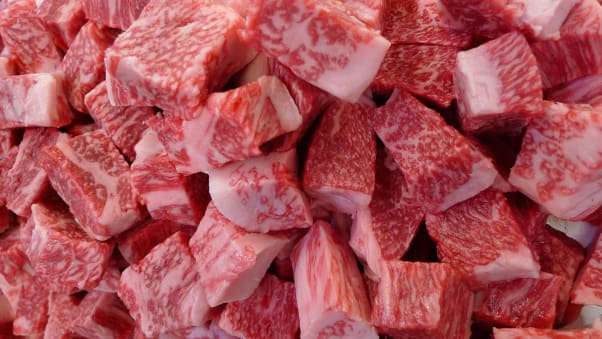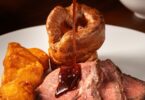(CNN): If you order a box of frozen Kobe beef croquettes from Asahiya, a family-run butcher shop in Takasago City in western Japan’s Hyogo Prefecture, it’ll take another 30 years before you receive your order.
That isn’t a typo. Thirty. Years.
Founded in 1926, Asahiya sold meat products from Hyogo prefecture — Kobe beef included — for decades before adding beef croquettes to the shelf in the years following WWII.
But it wasn’t until the early 2000s that these deep-fried potato and beef dumplings became an internet sensation, resulting in the ridiculously long wait buyers now face.
An unprofitable business idea
The highly coveted “Extreme Croquettes” are one of four types of Kobe beef croquettes available at Asahiya. Can’t wait three decades? The shop’s Premier Kobe Beef Croquettes currently have a more palatable four-year waitlist.
“We started selling our products through online shopping in 1999,” explains Shigeru Nitta, third-generation owner of Asahiya. “At that time, we offered Extreme Croquettes as a trial.”
Growing up in Hyogo, Nitta has been visiting the local ranches and beef auctions with his father since he was young.
He took over the shop from his father in 1994 when he was 30 years old.

“We sold Extreme Croquettes at the price of JPY270 ($1.8) per piece… The beef in them alone costs about JPY400 ($2.7) per piece,” says Nitta.
“We made affordable and tasty croquettes that demonstrate the concept of our shop as a strategy to have customers enjoy the croquettes and then hope that they would buy our Kobe beef after the first try.”
To limit the financial loss in the beginning, Asahiya only produced 200 croquettes in their own kitchen next to their shop each week.
“We sell the beef raised by the people we know. Our shop only sells meat that was produced in Hyogo Prefecture, whether it’s Kobe beef, Kobe pork or Tajima chicken. This has been the style of the shop since before I became the owner,” says Nitta.
In fact, Nitta’s grandfather used to ride to Sanda — another famous Wagyu-breeding area in Hyogo — by bike with a handcart to pick up the produce himself.
“Since around that period our shop had connections with local beef producers, so we did not have to get them from outside the prefecture,” Nitta adds.
Production boosted but popularity grows
The cheap price tag of the Extreme Croquettes flies in the face of the quality of the ingredients. They’re made fresh daily with no preservatives. Ingredients include three-year-old female A5-ranked Kobe beef and potatoes sourced from a local ranch.
Nitta says he has encouraged the ranch to use cow manure to grow the potatoes. The stems of the potatoes will then be fed to the cows, creating a cycle.
Eventually, his unique concept caught the attention of locals and media. When a report about Asahiya’s croquettes came out in the early 2000s, their popularity skyrocketed.

“At that time, we raised the price to JPY500 ($3.4)-JPY540 ($3.7) with consumption tax. But since the export of Kobe beef began, the prices of beef have doubled, so the fact that the production of croquettes makes a deficit has not changed,” says Nitta.
Production has also been boosted from 200 croquettes a week to 200 croquettes per day. “In reality, the Extreme Croquettes got way more popular than other products,” Nitta chuckles, laughing at his own money-losing business idea.
“We hear that we should hire more people and make croquettes more quickly, but I think there is no shop owner who hires employees and produce more to make more deficit… I feel sorry for having them wait. I do want to make croquettes quickly and send them as soon as possible, but if I do, the shop will go bankrupt.”
Fortunately, Nitta says that about half of the people who try the croquettes end up ordering their Kobe beef, so it’s a sound marketing strategy.
Nitta’s mission: Let more people enjoy Kobe beef
Each box of Extreme Croquettes, which includes five pieces, sells for JPY2,700 ($18.40).
The shop sends a regular newsletter to waiting customers updating them on the latest shipping estimate.
A week before the delivery date, the shop will confirm the delivery with the patient customers once again.
“Of course, some people have changed their email addresses. For those people, we call them directly and let them know the delivery date. They can change their address themselves through our website or when we call them, they can let us know,” says Nitta.
Customers receiving croquettes these days placed their orders about 10 years ago.
Having a 30-year list of unprofitable orders to fulfill can be stressful, especially as the price of Kobe beef and labor continues to rise.

“For that reason, I continued offering croquettes as a trial and get more orders for Kobe beef if they liked it. That was why I started it in the first place, so I didn’t really care if it was a deficit,” says Nitta.
One of the most memorable moments was when they got an order from a cancer patient who was about to go through surgery while waiting for their Extreme Croquettes.
“I heard that our croquettes were the patient’s motivation to go through surgery. That surprised me the most,” says Nitta.
The patient survived and placed multiple orders since then. Nitta received a call from the patient who told him “I hope to live long without reoccurrence of cancer” after sampling his croquettes.
“I still remember that. I was moved by the comment,” says Nitta. By letting more people enjoy Kobe beef, he hopes that the fame of these croquettes will help promote the local industry.
“I’m grateful. By becoming famous, I think I can help the whole industry, not just my shop, by making people who have not been interested in Kobe beef get interested. I want to have as many people as possible eat Kobe beef — not just from my shop,” says Nitta.
How to sample beef croquettes now
Asahiya now has two locations: their original store at Takasago City and a shop in Kobe city. Its frozen beef croquettes are only shipped domestically.
Though Asahiya primarily operates as a butcher, Nitta says travelers can visit their Kobe shop, where they sell two types of ready-to-eat takeaway snacks, called “Tor Road” and “Kitanozaka” croquettes, named after nearby streets.
“Kitanozaka” uses lean beef and is priced at JPY360 ($2.5) each. “Tor Road” uses short loin and chuck, and costs JPY460 ($3.1).
“We age the meat for 40 days and the potatoes for one month so that they will be sweeter,” says Nitta.
As for the future, the 58-year-old owner says they’re thinking about expanding.
“I would like to make a small space where people can eat a bit, maybe. Our Kobe shop is a tourist spot,” he says. “But if it becomes a restaurant, our neighboring restaurants might be annoyed because we supply the meat for them too.”







